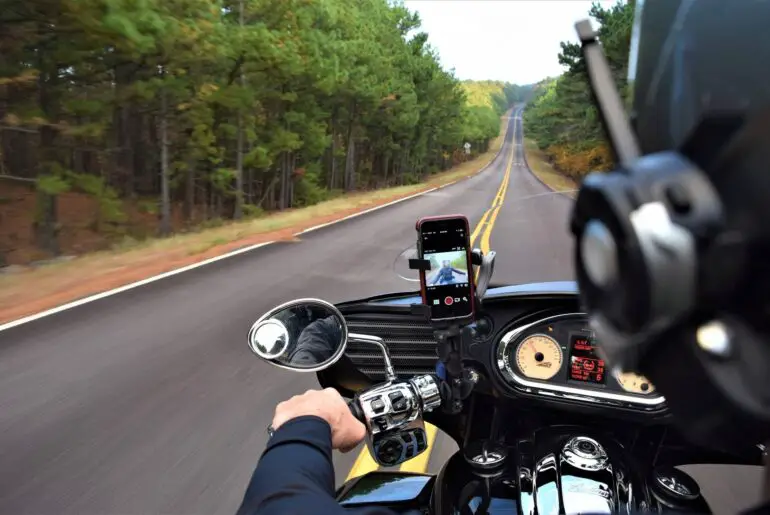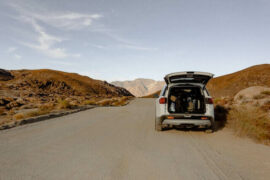Last Updated on January 30, 2023 by Rose Morah
Every motorcycle enthusiast knows that the beauty of going on a motorbike road trip lies in the enjoyment of every minute of the journey and the intimate experience with nature.
And again, only a biker knows why a dog sticks his head out of a car window.
I also like to view riders who enjoy going on long road trips as basically dreamers who make their exploring desires a reality.
This article is going to be a complete guide to long motorcycle road trips for beginners.
So, if you are just starting out on motorcycle road trips, these are the tips and tricks to consider:
Choosing the right motorcycle
The bike you are going to be riding makes all the difference.
A good road trip motorcycle guarantees you a better experience, especially if it is going to be a long ride.
This is because you will be seated in the same position for many hours.
Let’s take a look at the different styles of motorcycles to help you choose the right one for your type of road trip.
Styles of motorcycles
Though there are many different styles of motorcycles, not every style is suitable for long-distance travel.
The following are the recommended styles to consider when going on a long motorcycle road trip:
1. Touring Motorcycles
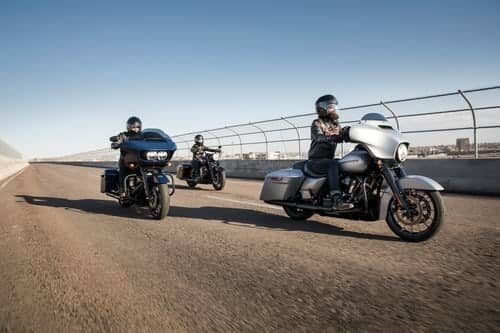
These bikes are designed for the sole purpose of long-distance travel because they provide a more upright riding position that would be comfortable when riding for many hours.
Unlike other motorbikes, these bikes don’t put a lot of strain on your back. They have spacious cargo space. The windscreen and the front fairing are also large enough, so you won’t have to keep fighting with the wind.
It is also important to note that there are two types of touring motorcycles; touring and sport touring bikes.
Both types are designed to provide comfort for the rider. But what’s the main difference between the two?
The following table gives the main differences between touring and sport-touring motorcycles.
| Touring | Sport Touring |
| Has more storage area | Has less storage area |
| Has a more relaxed seating position | Provides riders with a relaxed seating position |
| It has more weight | It has less weight |
| It has more room for the rear passenger | It has less room for the rear passenger |
| Some touring bikes have relatively low seat heights | They have a reasonably tall seat height. This is to give more ground clearance for better cornering. |
| They are slower | They are fast compared to touring motorcycles |
Kawasaki concours14, BMW Motorrad K 1600 GTL, and Honda GoldWing are some of the best examples of touring Motorcycles.
Kawasaki H2 SX SE+, BMW S1000XR, and Kawasaki Ninja 1000SX are examples of sport-touring motorcycles.
| How do I choose a touring motorcycle? It would be best to choose a comfortable touring bike that has a more carrying capacity and that is reliable. A comfortable touring bike should have great seating support, and its seating position should be flexible and ideal for long-distance touring. |
2. Cruiser Motorcycles
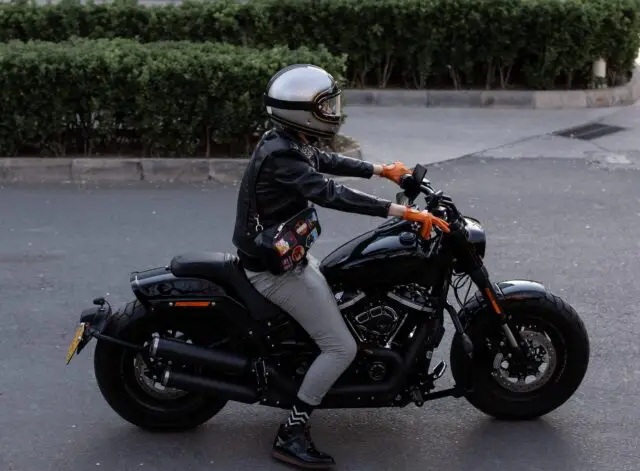
These bikes are also great for long motorcycle road tours and are a good alternative to touring motorcycles.
However, their cargo area cannot be compared to the touring bikes as it is smaller. They also lack essential features that would help block the wind while riding.
But on the flip side, their main upside is their lower, relaxed, and comfortable sitting position, which is great for long-distance travel.
Cruisers are designed to create maximum rideability on paved roads.
They are also ideal if you plan to ride on routes with few potholes because of their great tough tires.
Yamaha V-Star 250 Cruiser is among the best road trip cruisers for beginners.
I would say the main difference between a touring and a cruiser motorcycle is in their style, engine performance, comfort, storage, and customization.
While touring bikes offer great comfort and storage, cruisers have a higher engine performance, and they can be easily customized to suit your needs/wants.
So, are cruisers good for touring?
Indeed. Cruisers are great for touring. However, depending on your style and comfort, if you are planning to ride for long hours without putting a strain on your back, then you could consider customizing it for more comfort on long rides.
Related: How to prepare & ride a sports bike on a long road trip.
Now that we have learned about the different styles of motorcycles that you can use on your road trip, next, we take a look at must-have gears for your safety on the road.
Must-have motorcycle gear before a road trip
The importance of wearing proper motorcycle gear on your road trip can’t be emphasized enough.
Good motorcycle gear makes your road trip experience better and more comfortable in a wide range of situations.
For instance, it offers protection from sunburns, rain, wind, debris, noise, and even crashes. In other words, it acts as your second skin.
Remember: Even a minor crash could leave you severely injured.
A good set of gear is armored against impacts on the rider’s joints and is designed for abrasion resistance.
Let’s take a look at the must-have motorcycle gear:
1. Helmet
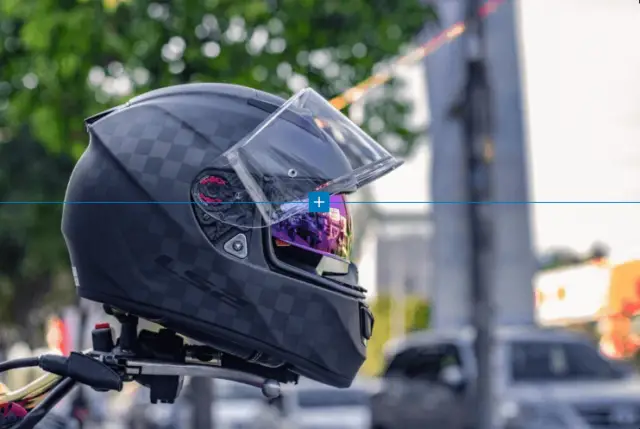
Before going on your motorcycle road tour, make sure that you have the correct helmet.
Additionally, make sure it properly fits and feels comfortable around your head. This is because helmets may hugely vary in shape and size depending on the models and the manufacturers.
Full-face helmets are the best for long-distance rides. They are also made specifically to offer you absolute protection in case of any road mishap.
If you plan to ride mostly during the day, you will want to budget for a tinted visor to prevent you from being blinded by the sunlight.
And before you purchase a helmet, remember to check the customer reviews. This is because you will want to know the experience of other riders in regard to other important factors such as aerodynamics, weight, and noise.
| Quick Tip: |
|---|
| Never buy second-hand helmets. Sometimes helmets can sustain unseen effects, especially after a crash. Therefore their performance may not be as effective compared to a brand-new one. This is because the material and adhesiveness of the helmet may have degraded. This would not properly protect you in the event of traumatic head or face damage resulting from a crash. |
How long do motorcycle helmets last?
Five years is the maximum life of most motorcycle helmets, assuming that the helmet has not had any accidents or great impact on it.
Does dropping a helmet ruin it?
No. Dropping a helmet cannot damage your helmet. Therefore, there is no need to replace your helmet if it drops. However, frequently dropping or spiking it hard on a hard surface will definitely degrade it. And another thing, there’s a greater probability that the helmet may get ruined when dropped from a significant height.
Are old motorcycle helmets safe?
Old motorcycle helmets are unsafe because the materials used to design the helmet may have been worn off completely. This would hence expose the rider to greater danger in case of an accident.
How often should you replace your motorcycle helmet?
You should change your helmet after 5 years. This rule only applies to helmets that haven’t encountered any impact that may degrade their materials.
What is the safest motorcycle helmet?
The safest motorcycle helmets must have the following:
- An impact-absorbing liner.
- It should have a thermoplastic or polycarbonate (this is a very strong material).
- Has a shell-built design.
How do I know if my motorcycle helmet is still good?
Reasons why you don’t have to replace your helmet:
- If there is no visible sign of cracks or deep scratches.
- If the visors do not have scratches or cracks that may hinder your visibility.
- If your helmet properly fits in your head firmly (does not slide when you shake your head). This also means that it does not have indentations in its foam lining.
- The straps are working properly.
- It does not flake off your shoulders or hair.
What happens if your motorcycle helmet is too big?
Wearing an oversized helmet exposes you to a lot of noise and wind, and may likely fall off in the event of a crash.
Which helmet color is best?
The yellow color is the best for helmets. Generally, brighter colors are the best because they make it easier for other motorists to see you when riding during the day and at night.
| Are you looking for a stylish e-bike at a budget-friendly price? Check out these varieties of models designed for every rider. |
2. Boots
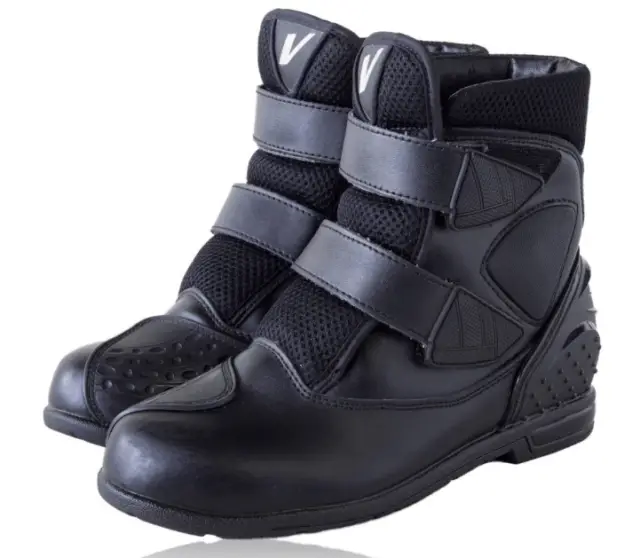
Do you really need motorcycle boots?
Absolutely. Motorcycle boots are essential because they give you extra protection in case of a crash.
It is important to go for non-slip soles, oil-resistant, and good ankle support boots because you’ll need to be able to ride your motorbike comfortably, even on unpredictable and slippery surfaces.
Make sure that they are also breathable waterproof boots.
3. Body Armour
It is essential to get approved back armor to protect you from spinal damage in the event of an accident.
Ensure all joints are protected by CE-approved armor inserts and fit properly with no movements.
You can also opt for the D30 armor, which properly molds your body shape when worn. The D30 armor is a protective gear designed to give you maximum protection when you’re hit hard by an impact.
4. Gloves
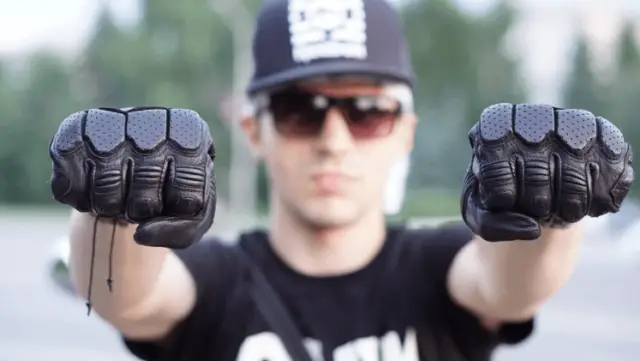
You will want to go for gloves that cover your hands completely, and with strong abrasion-resistant material.
But you’ll also want to ensure that:
- They have armor at the base of the palm
- They have armored knuckles to offer you protection from rocks, bugs, and debris from the asphalt in the event of a crash
- They have good ventilation to prevent your fingers and palms from sweating
- They are designed in such a way that they cover your entire wrist. They should also have armor for the ulnar bone as well
What are the best motorcycle gloves for cold weather?
The best motorcycle gloves for cold weather should have greater water resistance and features that enable them to withstand lower temperatures.
Some riders opt to go for heated gloves. But are heated motorcycle gloves worth it?
Absolutely. Heated motorcycle gloves are the best choice for any rider who wants to keep their hands warm when riding in cold weather conditions.
But don’t just take my word for it. Find out everything you need to know about heated gloves here.
5. Motorcycle Jacket
Always go for motorcycle jackets that have armor on the elbows, back, and shoulders.
6. Motorcycle Jeans
Choose a leather or abrasion-resistant textile that has knee and hip armor.
The bottom line is that every gear should be considered a necessity when going on your motorcycle road trip.
Other gear that makes your long motorcycle road tour more enjoyable.
- Heated grips – They provide you with extra warmth. This makes them a good option when riding at night, early in the morning, or in cold weather.
- Gel seats(s) – They provide extra seat support and improve your comfort when riding.
- Backrest – It adds extra support when you’re leaning back as you ride. The backrest can be mounted on your motorcycle together with the gel seat.
- A good windshield – You won’t have to constantly fight the wind.
You already know how to choose the best style of motorcycle that suits your road trip needs and style. You also know the right gear for the road tour.
Now, let’s take this bike for a tune-up.
Servicing your motorcycle before a road tour
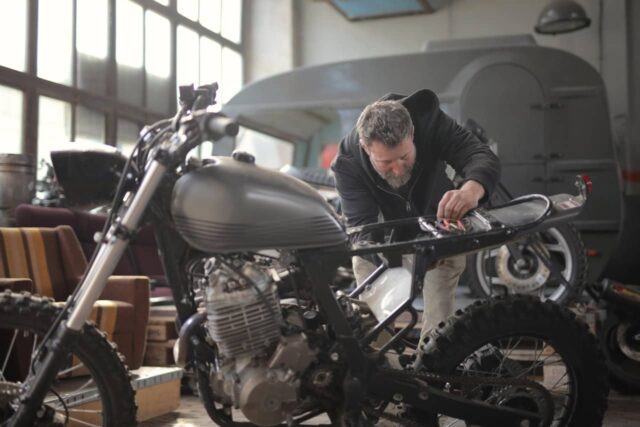
Your motorcycle needs some thorough tweaking before heading out for a long road tour.
Make sure your fluid levels, brakes, tires, lights, and any loose bolts are checked and tested. The frame suspension, fasteners, and chain should also be secure and intact.
You may need to take the motorcycle to a mechanic, even if it’s brand new or has recently been serviced.
Before you embark on the road tour, be sure to carry a basic toolkit and all essential spares such as brake cables, spare tubes, spark plugs, etc.
Basically, your toolkit should have the following:
- Replacement fuses
- Motorcycle jumper cables
- Locking and needle nose pliers
- Clutch cable/clutch saver
Next, we learn how and what to park.
Pack right
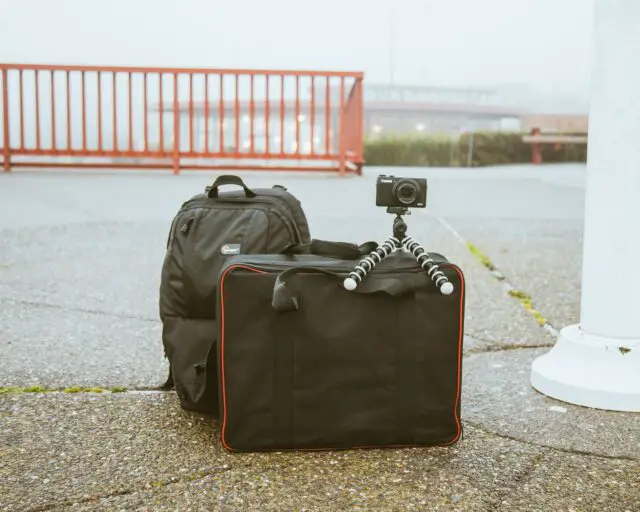
When packing for a long trip, you could start by packing items that have more than one use.
Carry disposable items that you can easily discard after use to create extra space. For instance, instead of carrying bottles, you can carry sachets.
What to pack on a long motorcycle road tour
- All-weather clothes – raincoats, warm jackets, rain gear, etc.
- Carry lightweight synthetic clothing that can be easily washed and dried overnight.
- Carry a small/medium towel that can comfortably be wrapped around your neck to keep water from running down your back during a rainstorm
- Carry a second fuel container as a backup in case you run out of fuel along the way. In any case, you will have peace of mind in the sense that your bike will make it to the next gas station.
- Carry eye drops
- Lastly, but very importantly, carry earplugs to protect your ears from the noise when you are riding
Don’t also forget to carry these essential items in an emergency kit :
- First-aid kit
- Cold and headache drugs
- Insect bite stick
- Emergency contact numbers
- A spare key
- Small flashlight and a candle
- Eyeglass repair kit
- Energy food bars
- Emergency blanket
| Remember to check the cargo weight limit of your motorcycle to avoid overloading it. |
Motorcycle road tour packing tips
- When packing your clothes, do not fold them, just roll them. This way you will take up less space.
- If you are traveling with a partner or as a group, you could consider sharing the packing list to avoid packing duplicate items that can be shared, such as toothpaste and shampoos.
- Get zipper-lock plastic bags of different sizes for packing your stuff. For instance, you can pack a day’s clothes in one zipper-lock plastic bag (jeans, shirt, and undergarments) to avoid unpacking everything every time you need to get changed.
This is also a great way of staying organized, and above all, time-saving.
When loading your luggage onto the motorcycle, make sure you load it towards the tank, distributing it evenly from side to side to keep the weight towards the motorcycle’s center of gravity.
Tips and tricks when touring on a motorcycle
1. Watch out for fatigue
Riding when you are tired is dangerous.
When riding on a long motorcycle road trip, you need to know when your body wants you to take a break.
Sitting on a motorcycle for hours without taking short breaks can cause saddle sores.
2. Have a backup plan
Sometimes you will encounter changing road conditions or rough weather conditions that might force you to change roads or original plans.
Therefore, you need to always prepare yourself psychologically for any changes and make adjustments.
3. Carry a paper map
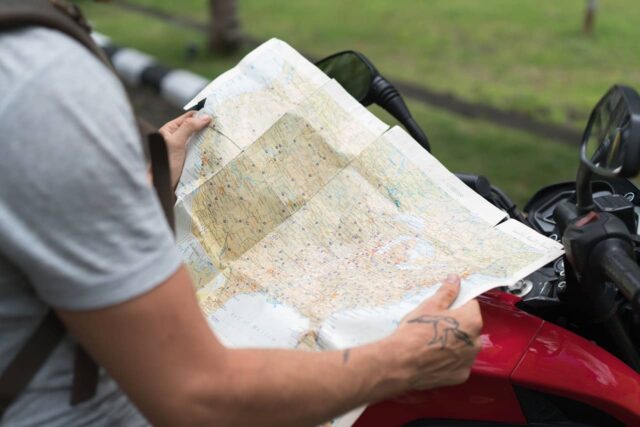
If you are taking a trip headed to an unfamiliar destination, then a GPS and hard copy maps will come in handy.
Be sure to invest in a helmet with Bluetooth and hard-copy maps that you can use in remote areas with no network.
You can also opt to download offline maps for use in places with poor cell service.
4. Be aware of country or state laws
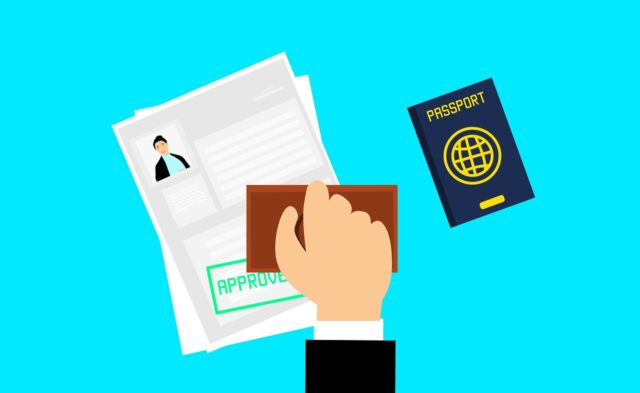
Be sure to review all the local laws of the country or state you intend to tour on your motorbike before you hit the road.
5. Carry an extra key
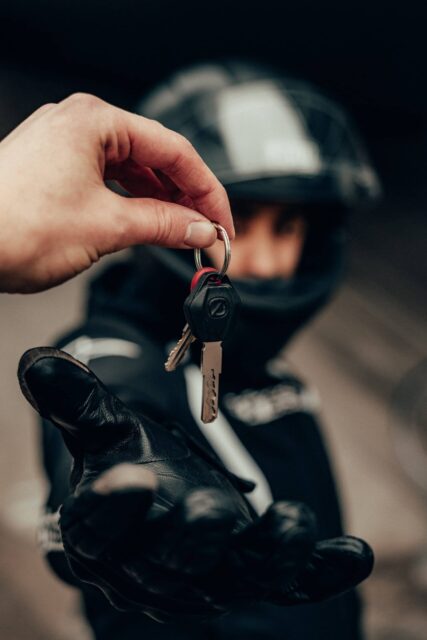
Many things can happen during a long road tour.
Losing items comes as no surprise.
A good rule of thumb is to always carry your motorcycle’s spare key and be mindful of where you keep it.
6. Stay motivated
Try to keep your spirits up irrespective of the circumstances.
Take time to stop along the way to sightsee, enjoy the highway attractions and make friends along the way.
Other tips
How cold is too cold for a motorcycle road tour?
Below 0°C is too cold to ride a motorbike. It is hence not advisable to ride when temperatures are too low ( below 0°C ) for the sake of your safety and health. You will also more likely be exposed to accidents this way, such as sliding or hitting the ice.
How do you prevent your hands from going numb when riding on a motorbike?
The following are ways to help prevent your hands from going numb:
- Ensure that your motorbike’s seat is adjusted correctly to your height
- Install higher handlebars before your road trip. This greatly helps reduce the pressure on your wrist
- You can opt to replace your handle grips with softer ones
- If numbing starts to happen, you can try and shake your hands vigorously
- Try to relax your grips

